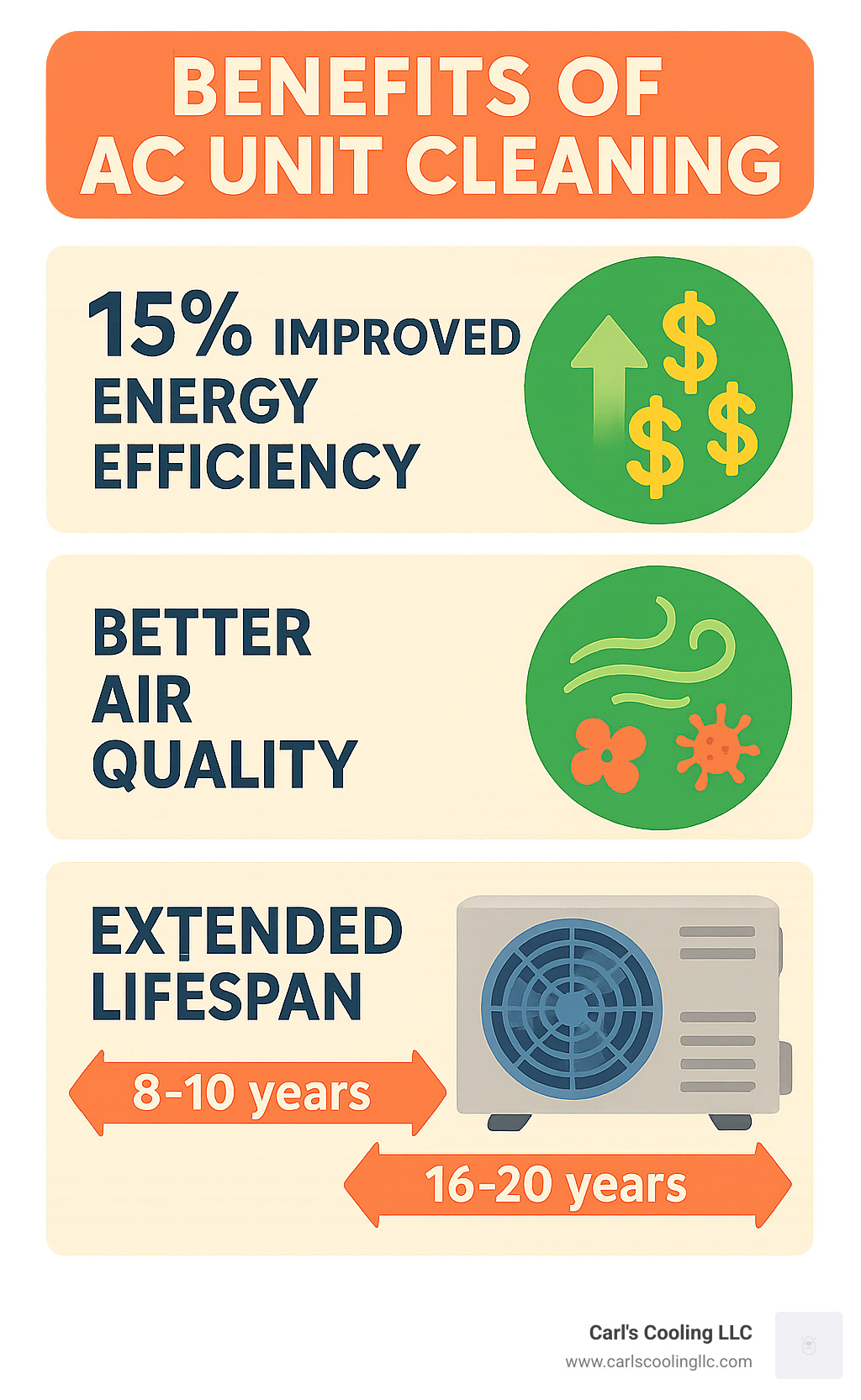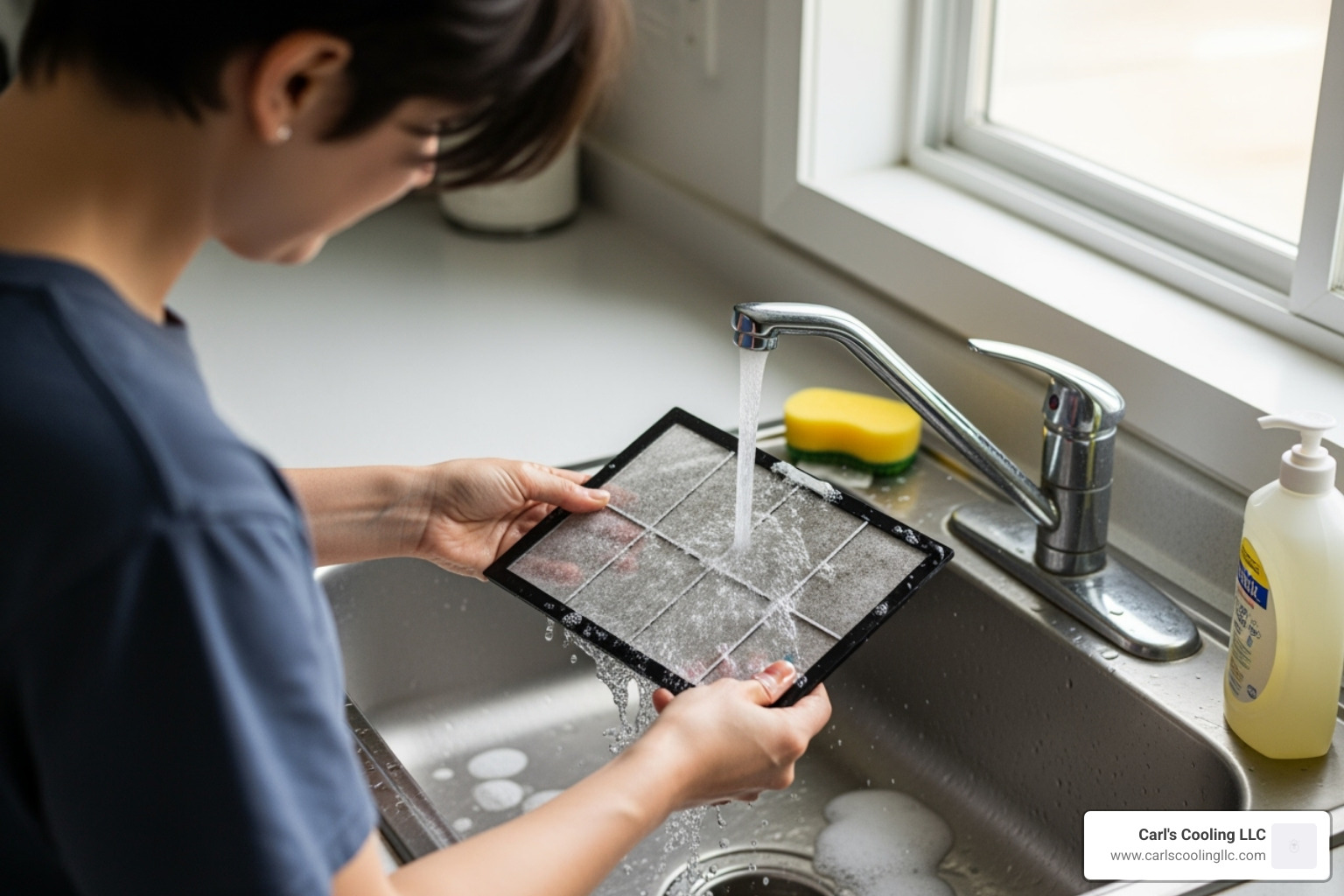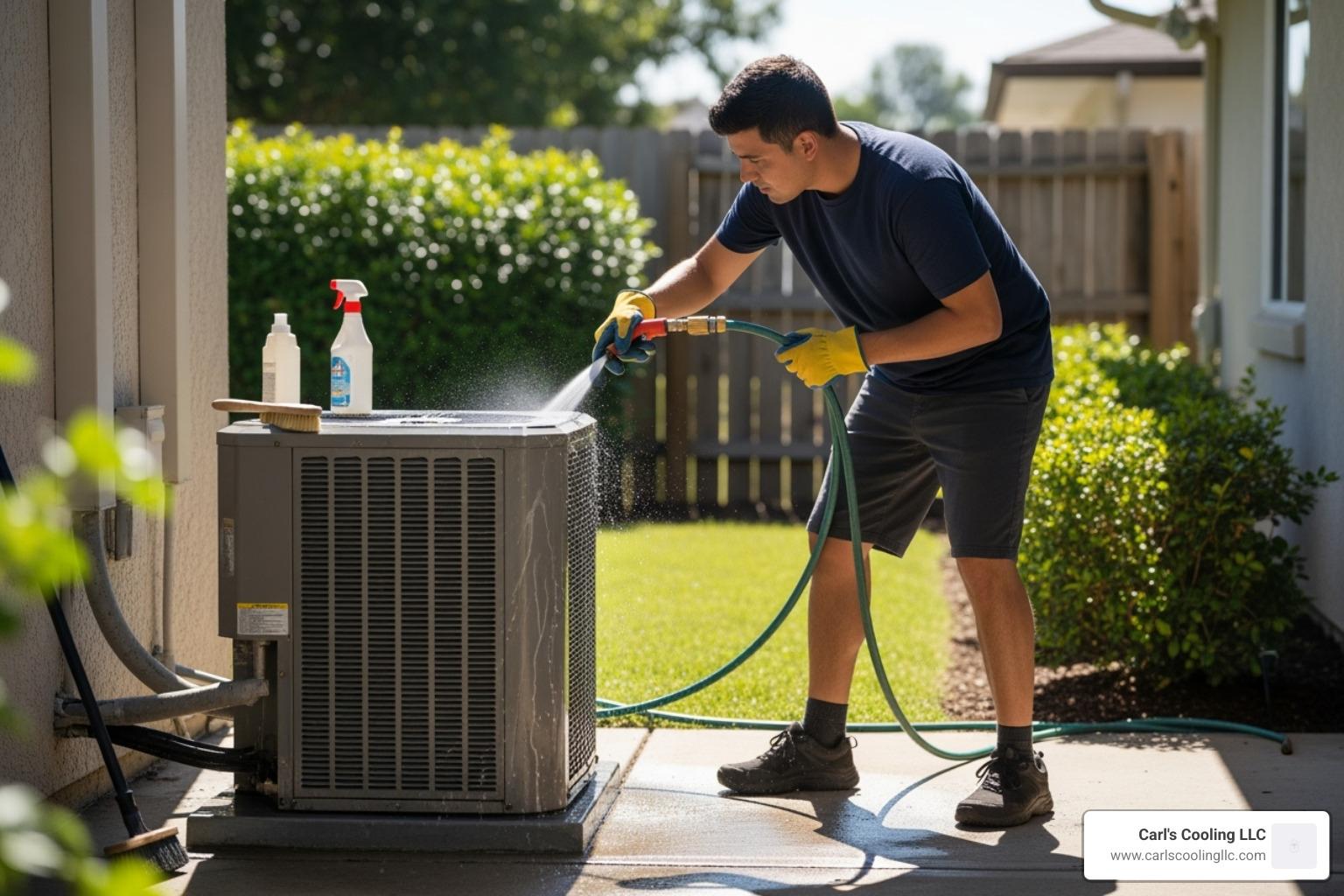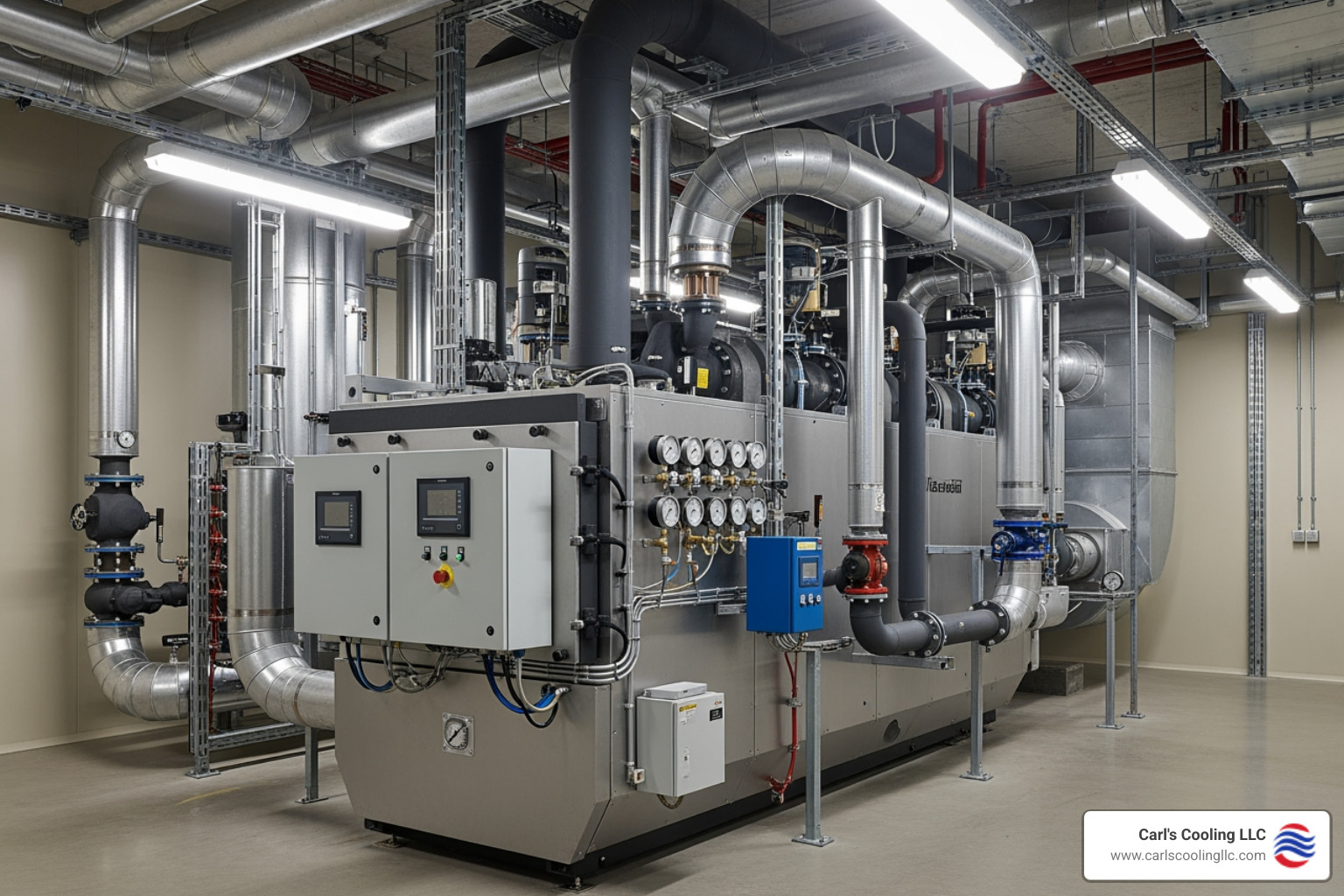Why Clean AC Units Keep Your Home Cool and Your Bills Low
AC unit cleaning is one of the most important maintenance tasks every homeowner should master. It's the difference between a system that hums efficiently and one that struggles to keep you comfortable while driving up your energy costs.
Quick AC Cleaning Essentials:
- Turn off power at the breaker and disconnect box
- Remove debris from around the outdoor unit
- Clean the coils with gentle brush and coil cleaner
- Straighten bent fins with a fin comb
- Replace or wash filters monthly
- Clear the drain line to prevent clogs
Think about stepping into a cool, comfortable home on a scorching summer day. That refreshing blast of cold air doesn't happen by accident - it comes from a well-maintained AC system that's free of dirt, debris, and the grime that accumulates over time.
Regular cleaning delivers three game-changing benefits for your home. First, your energy bills drop significantly. Research shows that regular coil cleaning can improve AC efficiency by up to 15%. Second, your air quality improves dramatically as clean filters and coils remove more dust, allergens, and contaminants. Third, your system lasts longer - potentially doubling the typical 8-10 year lifespan of modern AC units with proper maintenance.
The best part? Most AC cleaning tasks are surprisingly simple. You don't need special skills or expensive tools. With basic equipment like a garden hose, soft brush, and some mild cleaner, you can tackle the job in a few hours and enjoy the benefits all season long.

Why Bother? The Cool Benefits of a Clean AC
Your air conditioner works tirelessly all summer long, but when was the last time you showed it some love? Regular AC unit cleaning isn't just busywork - it's one of the smartest investments you can make in your home's comfort and your wallet's health.
Energy Efficiency That Actually Saves Money
Imagine trying to sip a thick milkshake through a clogged straw. That's how hard your AC works when its coils are coated in dirt and grime.
These coils are the workhorses of your cooling system, transferring heat to keep your home comfortable. When they're buried under layers of dust and debris, your AC has to work overtime just to maintain the same temperature. This extra effort shows up immediately on your energy bills.
The good news? Regular coil cleaning can boost your AC's efficiency by up to 15%. That's real money staying in your pocket instead of padding the power company's profits. Clean coils mean your system can do its job without breaking a sweat - or breaking your budget.
Better Performance and a Longer Life
A clean AC doesn't just save energy - it actually cools better too. When your system isn't fighting against dirt buildup, you'll notice more consistent temperatures throughout your home and better humidity control. No more sticky, uncomfortable days when your AC just can't keep up.
Proper care can double its lifespan. Most modern units are built to last 8-10 years, but with regular cleaning, you could stretch that to 16-20 years, saving thousands in replacement costs.
The alternative isn't pretty. Dirty coils force your compressor to work harder, leading to expensive repairs and early system failure. It's like running a marathon in work boots - something's going to give out sooner than it should.
Cleaner Air for Healthier Living
Your AC does more than just cool - it's also your home's air cleaning system. But when filters and coils get dirty, they become breeding grounds for mold, mildew, and bacteria. Every time your system kicks on, these unwanted guests get blown throughout your house.
This is especially important if anyone in your family deals with allergies or asthma. A properly maintained system with clean components actively removes airborne particles and reduces allergens, making your home a healthier place to breathe.
Ever notice a musty smell when your AC starts up? That's mold talking, and it's definitely not saying anything good about your indoor air quality. Regular AC unit cleaning prevents this growth before it starts, keeping your air fresh and your family healthy.
The Cost of Neglect
Ignoring your AC maintenance comes with serious consequences: reduced efficiency, higher energy bills, expensive repairs, and potential health issues. The risks of dirty AC units extend far beyond comfort - they can impact your family's wellbeing and your home's value.
For detailed information about these risks, check out the risks of dirty AC units to see just how important regular maintenance really is.
The bottom line? A little preventive care goes a long way. Your AC unit cleaning routine is an investment that pays dividends in comfort, savings, and peace of mind all season long.
Gather Your Gear: Tools & Materials for the Job
Getting ready for AC unit cleaning is like preparing for any home project – having the right tools makes all the difference between a smooth job and a frustrating afternoon. Think of it as setting yourself up for success before you even step outside.

The good news? You probably already have half of what you need sitting in your garage or utility closet. Let's walk through what you'll need to tackle this project like a pro.
Safety comes first, so grab your gloves and safety glasses. Your hands will thank you for the protection from dirt and cleaning solutions, and your eyes need shielding from any debris that might fly around. Trust me, getting AC coil cleaner in your eye is not the kind of excitement you're looking for on a Saturday afternoon.
For the actual cleaning work, you'll need a screwdriver set with both Phillips head and flathead options. Most AC panels come off easily, but you want to be prepared for whatever screws your unit throws at you. A shop vacuum with brush attachment is your best friend for sucking up all that accumulated dust and debris – it's much more powerful than your regular household vacuum and can handle the job better.
Your garden hose with spray nozzle is essential for the rinse cycle, but here's the key: keep it gentle. Think refreshing summer shower, not car wash pressure. High-pressure water can bend those delicate aluminum fins faster than you can say "expensive repair."
Speaking of fins, a fin comb is a specialized tool that straightens bent fins and restores proper airflow. If you don't have one, a butter knife works for minor bends, but the real tool makes the job much easier. A soft brush – whether it's an old paintbrush, toothbrush, or dedicated coil brush – helps you work stubborn dirt loose without damaging anything.
For cleaning solutions, commercial AC coil cleaner is worth the investment. Look for the foaming, no-rinse types that are designed specifically for AC systems. These cleaners penetrate deep and lift dirt away, then disappear with your unit's natural condensation. For lighter cleaning tasks, mild detergent mixed in a bucket works perfectly for filters and general wiping.
Finally, keep plenty of towels handy for cleanup and drying. A wet/dry vacuum can be incredibly helpful if you need to clear a clogged condensate drain line – a common issue that's easy to fix with the right equipment.
Having everything organized and within reach before you start makes the entire AC unit cleaning process feel less like work and more like taking care of something important in your home. Plus, you'll look like you really know what you're doing!
Your Complete Guide to DIY AC Unit Cleaning
Ready to roll up your sleeves? Now that you've got your cleaning supplies ready, it's time to dive into the actual AC unit cleaning process. The good news is that while it might seem intimidating at first, most homeowners can handle this job with confidence once they know the steps.
The approach varies depending on what type of system you have. Central air systems need attention both indoors and outdoors, while window and portable units are more straightforward. But here's the golden rule that applies to every single type: always disconnect the power first. Your safety is worth far more than any time you might save by skipping this step.
Step-by-Step AC Unit Cleaning for Central Systems
Central AC systems are like having two partners working together – your outdoor condenser unit and your indoor evaporator coil. Both need some TLC to keep your home comfortable and your energy bills reasonable.
Power Shut-Off: Your Safety Net
Before touching your AC unit, cut the power completely for your safety. Start by setting your thermostat to "off", then go to your breaker box and flip the switch for your AC unit (often labeled "AC," "HVAC," or "Furnace").
Your outdoor unit also has an exterior disconnect box on a nearby wall. Open it and either flip the switch to "off" or pull out the fuse block. This ensures no electricity is flowing to the unit.
Clearing Away the Outdoor Mess
Your outdoor condenser unit is like a magnet for debris. Leaves, grass clippings, cottonwood fluff, and sometimes even small toys from the neighborhood kids find their way into and around your unit. Removing debris starts with clearing everything within a 2-3 foot radius around the unit. Your AC needs room to breathe!
Once you've tidied up the area, it's time to open up the unit itself. Most models require you to remove a few screws to lift off the top grille and fan assembly. Set it aside carefully – those electrical wires aren't meant to be stretched too far. Use your shop vacuum to suck out any larger debris that's made its way inside. You might be amazed at what you find hiding in there.
Cleaning Condenser Coils: The Heart of the Operation
Here's where the real magic happens. Those condenser coils – the metal fins wrapped around your outdoor unit – are responsible for releasing all the heat your AC pulls from your home. When they're caked with dirt and grime, they can't do their job effectively.
Start with a gentle rinse using your garden hose. Here's a pro tip: spray from the inside out whenever possible. This pushes the dirt out the same way it came in, making the cleaning more effective. If you can't access the inside, spray directly at the fins from the outside, but never at an angle. And please, resist the urge to use a pressure washer – those delicate fins bend easily and you'll end up with bigger problems.
For stubborn buildup, apply a commercial foaming coil cleaner generously to the coils. Let it sit for 10-15 minutes to do its work. Many of these cleaners are designed to be "no-rinse," meaning your AC's normal condensation will wash away the residue, but a gentle final rinse certainly doesn't hurt.
Straightening Fins for Better Airflow
After cleaning, take a close look at those aluminum fins. Any bent sections restrict airflow and hurt your system's efficiency. Straightening fins is easier than you might think – just gently slide a fin comb over the bent areas. Don't have a fin comb? A butter knife works in a pinch, but be extra careful not to damage the tubing inside the fins.
Tackling the Indoor Evaporator Coils
Now for the indoor portion of your AC unit cleaning trip. The evaporator coil lives inside your home, usually tucked away in your air handler or furnace unit. You'll need to locate and remove the access panel – this is where that screwdriver set comes in handy.
Cleaning evaporator coils requires a gentler touch than the outdoor work. These coils tend to collect dust and sometimes mold, especially in humid climates. Use a soft brush like a paintbrush to gently remove loose debris. For deeper cleaning, a no-rinse coil cleaner designed for indoor use works beautifully – just spray it on and let the natural condensation process wash away the grime.
Don't forget about the drain pan sitting below the evaporator coil. This little catch basin collects all that condensation, and it can get pretty gunky. Clean out any standing water or sludge, then pour a 1:1 mixture of bleach and water down the drain to prevent mold growth.
Clearing the Condensate Drain Line
An often overlooked but crucial step is cleaning the condensate drain line, which carries moisture away from your AC. If it gets clogged with algae or mold, water can back up and cause serious problems.
The drain line is usually a PVC pipe extending from your indoor unit. To clear minor blockages, pour a mixture of equal parts warm water and white vinegar down the line. For stubborn clogs, attach a wet/dry vacuum to the outside end of the drain line and let it run for a few minutes to suck out the blockage.
Once everything is clean and completely dry, reassemble your unit carefully. Make sure all panels are secure before turning the power back on at both the breaker and the exterior disconnect. While DIY maintenance is incredibly valuable, some tasks require professional expertise. If you encounter refrigerant issues or complex electrical problems, don't hesitate to contact Professional AC maintenance services.
Simple AC Unit Cleaning for Window & Portable Units
Window and portable AC units are much more straightforward than central systems, making them perfect for beginners or anyone who wants a quick maintenance win. The process is simpler, but the benefits are just as significant.

Safety First: Unplugging the Unit
Just like with central systems, your first step is cutting the power. For window and portable units, this is as simple as unplugging the unit from the wall outlet. Easy enough, right?
Filter Cleaning: The Monthly Must-Do
Removing the filter is usually the easiest part of the whole process. Most filters slide out from behind the front grille or lift out from the top. If yours is the reusable type (usually mesh or foam), give it a good wash in warm water with mild dish soap. Scrub gently to remove all that accumulated dust and grime, then rinse until the water runs clear.
For disposable filters, simply toss the old one and slide in a replacement. Look for the little arrow on the new filter – it should point toward the unit, following the direction of airflow. Here's the crucial part: washing reusable filters means nothing if you don't let them dry completely before putting them back. A damp filter is an invitation for mold and mildew to set up shop.
Coils and Fins: The Delicate Work
With the filter out of the way, you'll see the evaporator coils – those metal fins that do the actual cooling work. Cleaning coils and fins requires a gentle touch. Use a soft brush or the brush attachment on your vacuum to remove dust and debris. Work slowly and carefully since these fins bend easily.
For stubborn buildup or musty odors, a foaming AC coil cleaner works wonders. Spray it on, let it sit for the recommended time, then wipe or rinse gently if the product requires it. If you notice bent fins, carefully straighten them with a fin comb or the edge of a butter knife.
Housing and Exterior Care
Wiping down the housing might seem like a cosmetic step, but it actually serves an important purpose. Use a damp cloth with mild soap to clean the entire exterior, including the front grille and side vents. For window units, if you can safely access the back portion that extends outside, give those condenser coils a gentle rinse with your garden hose.
The Portable Unit Water Challenge
Portable AC units have a unique quirk – they collect condensation in an internal water tank that needs regular attention. Draining portable units involves locating the drain plug (usually at the bottom or back), placing a bucket underneath, and letting all that collected water flow out.
If you can access the water tank itself, clean it with a mild soap solution or a mixture of white vinegar and water. This prevents mold and eliminates those musty odors that can develop. Here's a helpful trick: run your unit in "fan-only" mode for about 30 minutes before shutting it off. This helps dry out any hidden moisture pockets.
The Final Assembly
Before you plug everything back in, double-check that all cleaned parts are completely dry. This is especially important for filters and any areas where you used liquid cleaners. Ensuring parts are dry prevents mold growth and keeps your newly cleaned unit from developing problems.
Reassembly is simply the reverse of taking things apart. Make sure all covers and grilles click securely into place. Once everything is back together and dry, plug in your unit and enjoy the improved performance.
The beauty of AC unit cleaning for window and portable units is how quickly you can see and feel the results. Your unit will run more quietly, cool more effectively, and the air will smell fresher. Plus, you'll have the satisfaction of knowing you've extended your unit's life and improved your home's air quality with just a few hours of work.
Frequently Asked Questions about AC Cleaning
Let's be honest - AC unit cleaning can feel a bit overwhelming at first. We get it! That's why we've put together answers to the most common questions we hear from homeowners just like you. Think of this as your friendly guide to becoming an AC cleaning pro.
How often should I clean my AC coils?
Here's the golden rule: give your AC coils a thorough cleaning at least once a year. The best time? Right before summer kicks into high gear, usually in spring. This way, your system is ready to handle those scorching hot days without breaking a sweat.
But life isn't always that simple, is it? Some situations call for rolling up your sleeves more often. If you live somewhere with tons of pollen floating around (we're looking at you, tree-heavy neighborhoods), your coils might get gunked up faster than usual. The same goes if you're dealing with dusty conditions - maybe there's construction nearby, or you live on a dirt road.
Got furry family members? Pet dander is notorious for clogging up filters and settling on coils. You might find yourself cleaning every few months instead of annually. And if your AC runs almost non-stop during peak season, it's naturally going to collect more dirt.
Your filters need attention every single month, a recommendation from the U.S. Department of Energy. Clean filters are your first line of defense against dirty coils. If you have pets or severe allergies, consider checking them every two weeks.
What kind of cleaner is safe for AC coils?
This is where things can get tricky, so let's keep it simple and safe. Commercial foaming coil cleaners are usually your best bet for a deep clean. Look for the "no-rinse" varieties - these are designed to do their job and then get washed away naturally by your AC's condensation. Pretty clever, right?
For lighter cleaning jobs, especially on window or portable units, a gentle mix of warm water and a few drops of mild dish soap works wonders. Just spray it on, give the coils a gentle brush, and rinse with a soft water stream.
Here's a household favorite: a 1:1 mixture of white vinegar and water is fantastic for portable AC tanks and can help tackle mold and grime. Vinegar is nature's cleaning powerhouse, but use it sparingly on metal components of central units since it can sometimes cause corrosion over time.
Avoid harsh chemicals like bleach or strong acids - they might seem like they'd work better, but they can actually damage your coils' delicate aluminum fins. And please, for the love of cool air, never use a pressure washer! Those delicate fins will bend faster than you can say "expensive repair." A regular garden hose with a gentle spray setting is all you need.
When should I call a professional instead of doing it myself?
While DIY is great, some jobs require a professional. If you're dealing with anything involving refrigerant, step away from the toolbox. Handling refrigerant requires special equipment and licensing to handle safely.
Electrical problems are another hard no for DIY. Flickering lights when your AC kicks on, strange buzzing from your electrical panel, or circuits that keep tripping? These are serious safety concerns that need professional attention.
Sometimes the signs are more subtle. Maybe you've done everything right - cleaned the filters, scrubbed the coils, cleared the drain line - but there's still that persistent musty smell hanging around. This could mean mold has taken up residence deep in your ductwork or other hard-to-reach places. A professional can perform a thorough inspection and duct cleaning if needed.
If your AC is still struggling after a thorough cleaning, something else is probably going on. Reduced cooling performance, strange noises, or higher-than-usual energy bills despite clean coils might indicate mechanical issues that require expert diagnosis.
And here's the most important point: if you don't feel confident about any part of the process, don't push it. There's absolutely no shame in calling a professional. Your safety comes first, and a trained technician can spot potential problems that might fly under your radar. Sometimes that professional eye can catch small issues before they turn into wallet-draining disasters.
Conclusion
Congratulations! You've just learned how to transform your AC from a dust-collecting energy hog into an efficient, clean-air powerhouse. AC unit cleaning isn't rocket science – it's just smart homeownership that pays dividends every single day.
Think about what you've accomplished here. You now know how to keep your air cleaner by removing allergens, dust, and mold before they circulate through your home. Your family will breathe easier, and anyone with allergies or asthma will definitely notice the difference.
You're also going to love those lower energy bills. We talked about how clean coils can improve efficiency by up to 15%? That's real money staying in your pocket instead of going to the power company. And with proper maintenance, you're looking at potentially doubling your AC unit's lifespan – that's thousands of dollars in replacement costs you won't have to worry about for years to come.
The beauty of this whole process is that most of it really is simple. Change those filters monthly, give your coils an annual cleaning, and keep debris away from your outdoor unit. These small steps prevent the big headaches that come with system breakdowns and expensive emergency repairs.
Of course, we know that sometimes life gets busy, or you might run into issues that need a professional eye. Maybe you've spotted a refrigerant leak, or that musty smell just won't go away no matter how much you clean. That's exactly when Carl's Cooling LLC steps in. We've got the expertise to handle the complex stuff, so you can focus on the simple maintenance that keeps everything running smoothly.
Your AC works hard to keep you comfortable – now you know how to return the favor. Clean air, lower bills, and a system that lasts for years? That sounds like a pretty cool deal to us!
Ready to take your AC maintenance to the next level? Schedule your professional AC service today!






